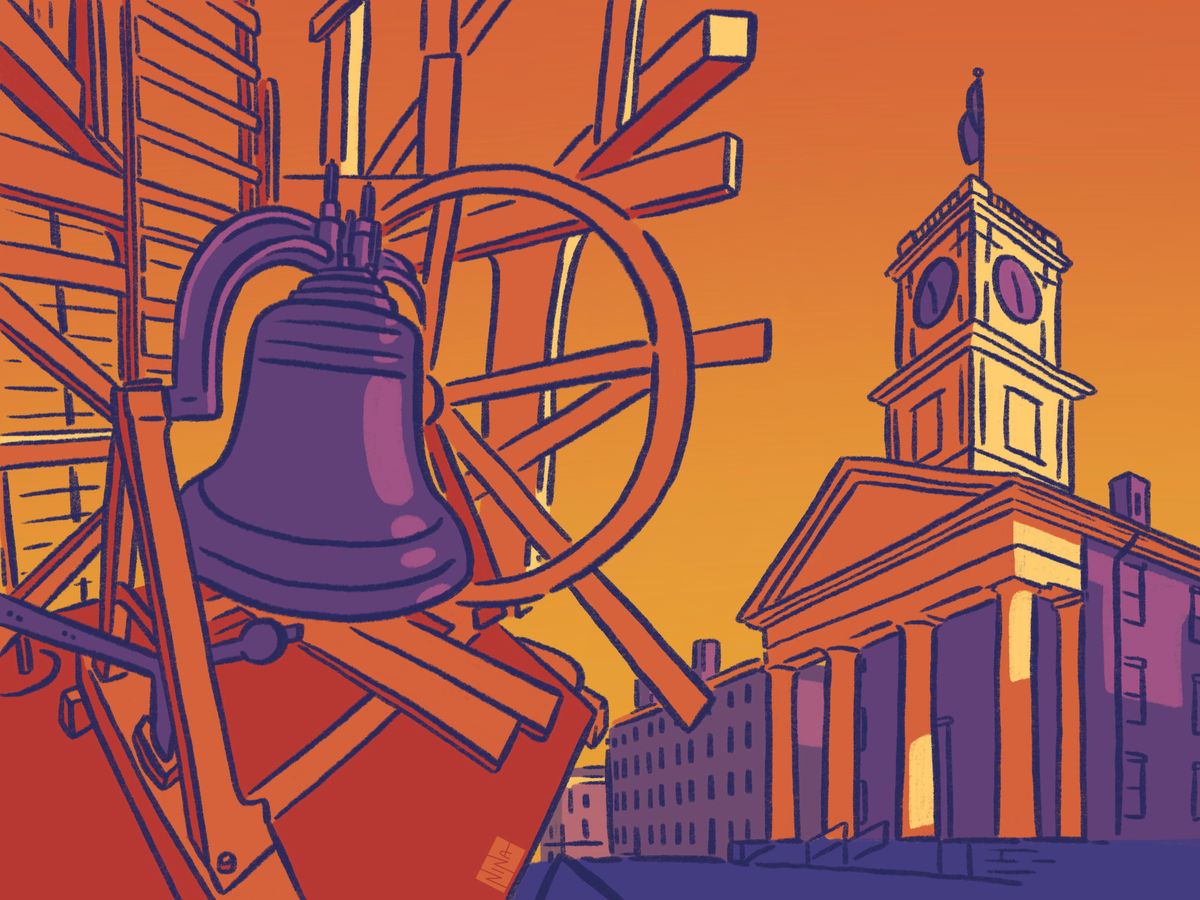You Won’t Bell-ieve It: Inquiries on the Johnson Chapel Bell
In her final article for The Student, Managing Features Editor Emeritus Caelen McQuilkin ’24E explores how the Johnson Chapel bell functions, and reflects on her time at The Student in the process.

We hear it every day, on the hour — or at least close to the hour. The Johnson Chapel bell: How does it ring? Who oversees this process? And what are some stories connected to this noise, which sometimes fades into the subconscious, yet remains a daily fixture at Amherst?
Reporting on these questions for the past week, I did not find a singular or definitive story. In close to 30 calls, emails, and interviews with the service center, facilities department, communications department, college archivists, custodial department, and fellow students, many people shared their specific knowledge and expertise about the bell, but none were without some level of confusion about the mysterious bell. Ultimately, this article took shape through a wide variety of perspectives, emerging across multiple branches of the Amherst community. That’s a story that may be difficult to sum up in a sentence, but I think the sentiment still rings quite true.

Today, the bell you hear ringing from Johnson Chapel is automatically operated, and programmed to ring on the hour during the day. The one exception to this rule, said Custodial Supervisor Jeremy Gonzalez, happens every year on Commencement. That’s when someone — usually a member of the custodial department — manually rings the bell in a special pattern to commemorate graduating seniors. A switch inside a locked closet in Johnson Chapel connects to the bell. To ring the bell, you flip the switch.
Gonzalez has rung the bells for three Commencements now. He described his reaction when he first learned what the ringing actually entailed: “They told me, ‘You’re gonna ring the bells,’ and I’m thinking, ‘Am I going to be hitting a bell, or pulling some type of string?’” he said. “And then when they took me to the closet, it was just a switch … I was less excited when I saw the switch. But it was still cool, because I got to ring the bells.”

This setup hasn’t always been the case. Some records of the bell’s changes sit in the college’s Archives and Special Collections, including one small booklet titled “Arrangement of bell-ringing for college exercises, and contracts for work.” The book is entirely handwritten and the last 20 or so pages are completely blank, giving it the feel of something more like a journal for keeping track of information. The writing inside keeps a detailed account of the schedule for ringing the bell, and the students who applied for the job to do so — the first entry is in 1853, and the last is in 1876.

The organization of this book shows a lot about how the bell has looked and operated differently throughout the college’s history.
For one thing, the book records three different bell ringing schedules for each academic year, splitting it into “fall term,” “winter term,” and “summer term.” And rather than ringing every hour, the bell had a set schedule marking different parts of the day for students. In the fall term of 1855, for example, the “first hour bell” rang at 6:20 a.m. Then, the “1st rec” rang at 8 a.m., the “study bell” at 9:30, “2nd rec” at 11:30, and “3rd rec” at 4 p.m. After Oct. 25, however, “3rd rec” changed to 3:45.

While fascinated by the changing schedule based on time, I had no idea what “rec” stood for, so I asked the person working at the archives desk. They hypothesized that it might stand for “recitation,” or class period.
Indeed, it seems that at this time, the bell indicated the start of class, which was in part determined by available sunlight. In the fall semester, for example, faculty decided to start “afternoon exercises” at 4:30 in the beginning of the semester, and then shifted to starting earlier, at 4, as the daylight hours shortened.
According to Campus Utilities Engineer Aaron Hayden, the bell was also connected to a bigger, synchronized system where it rang in every building and classroom on campus to indicate the class change.
During the 1850s, students were largely responsible for ringing the bell, and could apply for the position to do so. In 1858, the job, which paid one dollar per week, also included the responsibility of sweeping and lighting the chapel. Every year, the college hired a new student for this responsibility and kept track of employees in the booklet.

So what happened between the manually-rung bell of the mid-1800s and our lightswitch-operated bell of today? An excerpt from “Amherst College: The Campus Guide” by Blair Kamin ’79 shares some information about these shifts. “For years, the College required attendance at chapel services, and students rang the chapel’s 1,200-pound bell,” Kamin writes. However, in 1968, the college stopped holding these services, and eventually introduced electronic bells. This system introduced a new mechanism which rings the bell, abandoning the original weight-powered one, said Hayden.
Since then, the schedule for the bell has changed too. But the fact that it often rings off the hour today may not be anything new: in the Sept. 14, 1988, issue of The Student, Jennifer Matthews ’91 jokingly wrote, “The bell schedule for Johnson Chapel is the same: There is none.”
With more historical information at hand, I became more curious about what other stories might be associated with the bell today. In a slightly far-fetched attempt to reach more people who might have something to say, I hung a poster on the door close to the bell in the hope that someone might find it.

The next afternoon, my hopes became a reality when I picked up a call from an unknown 413-area-code number. While the person who found the note and called me said they weren’t interested in recording an official interview or sharing their name, they were OK with me including some of their knowledge about the bell.
They recounted some experiences ringing the bell on Commencement, and how it felt “nerve wracking” to stand there watching the second hand tick by on their watch in order to get the ringing pattern correct.
Gonzalez also reflected on the experience, noting that 15 minutes of ringing the bell at exact intervals was difficult at first — 15 minutes is longer than it might seem. “The first time, I was a little nervous, because I was like, ‘I don’t want to mess it up,’” he said. “I’m on the phone with my director, and he’s letting me know when to start. Because you have to start at a certain time, when the music stops… that’s when you start ringing the bell. So he’s on the phone with me, letting me know, ‘OK. Go ahead, start.’ I’m kind of nervous like, ‘I don’t want to double ring it. I don’t want to start at the wrong time…’ But it was good.”
I asked both Gonzalez and the anonymous facilities member if they knew more details about the bell, like how the electronic system works, or why it often doesn’t ring on the hour. What they do know is that there is still a large bell on top of Johnson Chapel, which the switch connects to, and that whenever the timing is off, it’s probably because the clock the switch is programmed to follow is wrong.
As I ponder these unanswered questions and others, I think back to the fact that this article is the last I will ever write for The Student. My time writing and editing for this paper has been defined by questions. How has the admissions process and Amherst’s goals of being more equitable shifted over time? What happens after dorm damage, and how does it affect custodial staff? How did the campus community feel two years after campus closed due to the Covid-19 pandemic? I’ve asked people, “What makes you care about this?” “How did you feel?” “What brought you to this place?” … and a range of so many other questions.
The Johnson Chapel bell is another question that only, ultimately, led me to more. Like so many of the other stories I’ve had the honor of writing for this newspaper, there is still so much we don’t know, so much that will never get printed in these pages. But I think that’s the point. I see it as a reminder that we are responsible for continuing the story of this place, in the conversations we have and the questions we ask.






Comments ()